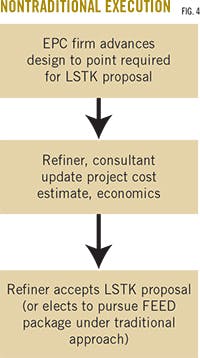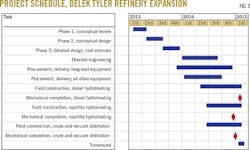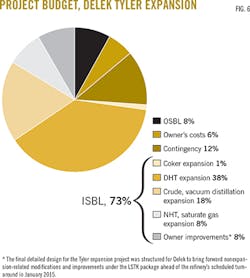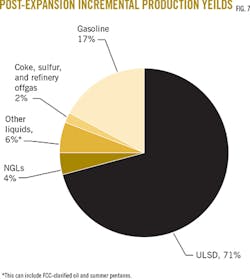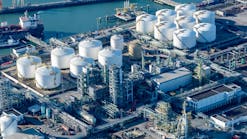Nontraditional approach to refinery revamp cuts time, adds flexibility
James W. Jones
Turner, Mason & Co.
Dallas
Frank Simmons
Delek Refining Inc.
Tyler, Tex.
Tony D. Freeman
KP Engineering LP
Tyler, Tex.
Delek Refining Inc., a subsidiary of Delek US Holdings Inc., Brentwood, Tenn., used a nontraditional project development and execution approach to expand crude oil processing capacity by 20% at its refinery in Tyler, Tex.
This article, the first of a two-part series, discusses project planning and execution. Delek collaborated with its refining consultant, Turner, Mason & Co. (TM&C), and preselected engineering, procurement, and construction (EPC) contractor KP Engineering LP (KPE), to implement the new approach.
A fundamental feature of the nontraditional approach used for the Tyler refinery expansion project was the belief that refineries should not be bottlenecked by low-cost process units. This approach additionally emphasized identification of high-return modifications leveraging the refinery's existing process units and supporting installations before determining the eventual design basis.
The Delek refinery expansion's basic concept specifically followed TM&C's experience that bottlenecks in distillation and hydrotreating units should not cause low utilization of refinery conversion units.
Growth in light domestic crude oil production has exacerbated this phenomenon.
Part 2 of this article will describe the specific modifications made at the refinery, which in addition to expanding overall capacity, simultaneously improved the refinery's rates of distillate recovery and its ability to process lighter feedstock.
Project conception, development
TM&C and KPE conceived the preliminary proposal for the expansion project in early 2013. Delek approved a phased study for the project based on principles TM&C and KPE used in previous collaborations, leading over 10 months to the reconfiguration used for the Tyler expansion.
The approved expansion project involved modifications to the atmospheric and vacuum distillation units, naphtha hydrotreater (NHT), diesel hydrotreater (DHT), and saturate gas unit, as well as a minor but important modification to the delayed coker's fractionator.
Detailed design on the project was developed in collaboration with Delek staff and was based on the TM&C-KPE team's focus on debottlenecking distillation and low-to-medium hydroprocessing operations instead of more costly modifications to conversion units such as fluidized catalytic crackers (FCCs), hydrocrackers, continuous catalytic reformers (CCRs), and delayed cokers.
Since its acquisition by Delek in 2005, crude rates at the refinery have steadily climbed in response to the growth in domestic light crude oil volumes and widening crack spreads. The refinery, which historically was constrained by FCC capacity, also became limited by the NHT, DHT, saturate gas, and crude units as its Permian basin crude supply became lighter.
While its extra coking capacity processed a sister refinery's excess vacuum bottoms, the refinery's CCR became underused. The FCC remained full, but more than 25% of its feed was distillate boiling-range material. TM&C and Delek believed overall refining capacity could be increased by improved recovery of distillate boiling-range material from the atmospheric (AGO), light vacuum (LVGO), and heavy coker gas oil (HCGO) streams and the resultant indirect increase in FCC capacity.
To validate this concept, TM&C approached KPE, with whom it had previously collaborated on a similar expansion project featuring a high-incremental distillate yield at a refinery in Wynnewood, Okla., for its perspectives on the possibility of increasing distillate recovery at the Tyler plant.
In addition to its experience on the Wynnewood project, which involved installation of a new vacuum unit equipped with an upper-fractionation zone, KPE had previously designed the revamp of an existing vacuum tower for increased distillate recovery at a refinery in Cheyenne, Wyo.
The distillate present in Delek's AGO and LVGO streams stemmed from simple equilibrium and not subpar fractionation in the crude unit's atmospheric tower, and KPE concluded that much of the distillate being left in the Tyler refinery's FCC feed could be recovered by modifying the vacuum tower.
An expansion of the crude unit's overall capacity with the addition of a preflash tower appeared feasible, and was logical given the increasingly lighter feed. Assuming NHT and DHT capacity increases could be made in a cost-effective manner, a refinery expansion on the order of 15-25% was obtainable for a reasonable cost. Further, the combination of improved distillate recovery and robust distillate crack spreads offered potentially favorable project economics.
The entire project, however, rested on distillate recovery from the FCC feed.
Phases 1, 2, and 3
The next step was to obtain funding for a process study. Delek wanted assurances of feasibility before committing to a significant design effort, so a phased approach to the process study was proposed.
The initial phase would solely focus on the degree of distillate recovery that could be obtained and how much expansion that would allow in terms of additional space in the FCC.
As much as 3,000 b/cd of distillate could be recovered from the refinery's typical 62,000-b/cd charge rate of 41° API crude. This recovery would require a vacuum tower top replacement similar to that used at the Cheyenne refinery, which would yield as much as 2,000 b/cd of additional straight-run diesel from the AGO and LVGO streams.
Another 1,000-b/cd of distillate could be recovered from the HCGO stream via additional heat removal in the upper sections of the coker fractionator. This volume of distillate recovery suggested that another 12,000-b/cd of crude runs were possible when only considering the FCC capacity limit.
Based upon its own outlook for long-term prices, TM&C developed proforma refinery economics for a 75,000-b/cd operation, which indicated a potential increase in pretax net refinery margin of about $40 million/year following project completion.
This economic potential prompted a second, more detailed process study to identify cost-effective modifications to the crude tower and downstream units geared toward increasing overall refinery capacity to as much as 75,000 b/d. Aware of the potential for the refinery to face even lighter feedstock options, Delek requested that any new additions and modifications accommodate crude oil with a gravity up to 42.5° API. Delek, TM&C, and KPE also recognized that a number of other improvements could be implemented at a reasonable cost as part of the proposed project.
Phase 2 identified the most cost-effective modifications needed at each process unit and confirmed the project's design basis.
This approach, which placed much of the design work ahead of establishing the basis for design, deviated from traditional project methodology and can be troubling for some refiners.
It, however, led to the most cost-effective design for revamp and debottlenecking, especially with the refiner's staff working in collaboration.
Delek allowed employees from across a broad spectrum of responsibilities to contribute to project development and design, maximizing the project's overall economic return.
Fig. 1 shows the traditional approach to project development. Fig. 2 shows the nontraditional approach TM&C, KPE, and Delek used for the Tyler expansion project.
The Phase 2 study considered the potential impact of infrastructure limitations and constructability issues. These steps typically occur later in the traditional project approach, but tailoring the eventual process modifications to the constraints presented by the refinery's plot plan and ancillary units was the only way to achieve cost-effective design.
In order to limit spending, Phase 2's scope took in only fundamental process design.
Upon completion and review of the Phase 2 process design in August 2013, Delek approved a third and final study phase to flesh out the project to the extent needed for a go-or-no-go decision.
Phase 3 included:
• Piping and instrumentation diagram development.
• Equipment sizing and quotations.
• Identification of bulk civil, piping, structural, and electrical needs.
• Final plot plans.
• Utility balances.
• Outside battery limits (OSBL) needs.
• Project schedule.
• Cost estimate.
Because Delek had a turnaround (T/A) scheduled to begin end-January 2015, the detailed design work needed to incorporate the ability to bring certain modifications on-stream independently of the existing units in the event equipment deliveries and the construction schedule didn't allow completion by the end of the T/A.
Final design included two parts: pre-T/A and T/A. To limit cost and ensure good control of the project, final design maximized the amount of pre-T/A work that could be executed independent of refinery operations, avoiding the more intense atmosphere (and higher cost) associated with T/A activity. This approach would also maximize the amount of work that could be executed, if desired, on a lump-sum turnkey (LSTK) basis.
The design effort also sought to minimize the burden a 20% capacity increase would have on the refinery's existing utility provider and infrastructure, bearing in mind how exceeding the tipping point on ancillary equipment could significantly increase OSBL costs.
Project execution
From project inception, TM&C encouraged Delek to sole-source an LSTK agreement with KPE because of the companies' collaborative experiences with each other on several similar projects at the Wynnewood refinery, one of which was executed on a sole-source basis. Based on the success of that project, TM&C was convinced that this would be the most cost-effective approach for Delek.
The execution plan chosen for the Tyler refinery project differed considerably from the traditional route taken by operators. Under the more traditional approach, operators establish a design basis and prepare a process design package, after which they obtain a front-end engineering and design (FEED) package, develop a more definitive cost estimate, and finally solicit competitive bids.
Fig. 3 shows the traditional approach.
By obtaining an LSTK proposal from KPE for the pre-T/A portion of the work, which was something KPE agreed to submit upon completion of the Phase 3 study, Delek shortened the schedule needed to execute the project while retaining sufficient cost certainty.
TM&C advocated that there was greater potential economic benefit to Delek by shortening the schedule than executing the project in a traditional manner. This fast-track, nontraditional approach also allowed for completion of any relevant tie-in work needed ahead of the T/A (Fig. 4).
The placing of purchase orders followed tentative project approval.
A few long-lead items had been ordered, on an item-by-item basis, during fourth-quarter 2013, prior to full completion of the Phase 3 study. Engineering and procurement activities continued for several months. Following formal approval of the project, Delek and KPE agreed to execute the pre-T/A inside battery limits (ISBL) work on an LSTK basis. An updated scheduled for the project followed Delek's formal approval (Fig. 5). The revised scheduled called for initial site construction activities to begin in July 2014, with pre-T/A modifications to the crude, vacuum, NHT, and saturate gas units due for mechanical completion by end-2014.
The DHT work, which determined the project's path, carried into February 2015, but still finished before completion of the refinery's scheduled T/A. Project work that could only be performed during the T/A would be executed on a reimbursable basis by Delek's T/A contractors under the direction of Delek's in-house project team. The required OSBL modifications were to be executed under the same approach but by contractors that Delek typically employed for small jobs.
TM&C continued to act on Delek's behalf throughout project execution by assisting Delek's in-house project management team, resolving certain project issues with KPE, participating in hazard and operability reviews, and assisting in the design and execution of the OSBL work.
TM&C also helped Delek:
• Update its operating procedures.
• Train employees on upcoming changes.
• Commission and start-up post-project.
This continued presence minimized scope creep.
Project cost, economics
The project's budget was $70 million, of which about 65% went toward ISBL additions and modifications associated with the refinery's actual expansion. Another 8% went toward owner-driven ISBL improvements not specifically related to the expansion project. About 80% of that collective ISBL amount involved work executed by KPE and included under the LSTK agreement.
OSBL work constituted only 8% of the budget, with the remainder going toward owner's costs and contingency.
Fig. 6 shows the budget for the Tyler refinery expansion project.
The project's final cost met the budget amount.
The refinery's increased crude processing capacity will also yield a large volume of ultralow-sulfur diesel on an incremental basis (Fig. 7).
Based on May 2015 crude oil and refined products future prices, the project's anticipated economic benefits currently appear more attractive than projected and should result in a simple pretax payback period of 15-18 months.
The second installment of this article will provide details of the specific modifications made to achieve processing improvements included as part of the refinery's expansion.
| . |
| Based on a presentation to the 2015 AFPM Annual Meeting, Mar. 22-24, 2015, San Antonio, Tex. |
The authors
James W. Jones ([email protected]) is a senior vice-president with Turner, Mason & Co. He leads assignments that involve refinery process technology studies, project management, and petroleum economics. Jones joined the firm in 1994 after 18 years with La Gloria Oil & Gas Co., where he held numerous positions at their Tyler, Tex., refinery, including 8 years as operations manager. He holds a BS in chemical engineering from the University of Texas, Austin, and an MBA from the University of Texas, Tyler. Jones is a licensed professional engineer in Texas.
Frank Simmons ([email protected]) is vice-president of refining best practices for Delek Refining Ltd., where he works with both the Tyler and El Dorado, Tex., refineries to identify and implement best practices in all areas of operations. He previously served as manager of Delek's Tyler refinery, before which he worked as a process engineer with La Gloria Oil & Gas Co. Simmons holds a BS (1985) in chemical engineering from the University of Texas, Austin.
Tony Freeman ([email protected]) is principal process engineer at KP Engineering LP, Tyler, Tex., with 27 years of experience in refinery process design. He holds a BS in chemical engineering from the University of Arkansas and is a registered professional engineer in Texas and Oklahoma.



